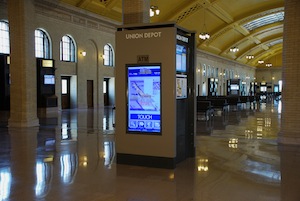Fans of historical transportation will certainly find the story of the Union Depot in downtown St. Paul, MN fascinating. First opened in 1881, the station burned down in 1913. A new station, the current Union Depot, opened in 1923 and was fully completed in 1926. It had nine railroads and 282 daily train movements at its heyday in the Roaring ’20s.
However, people change along with the times. A slow, steady decline based on emerging travel options led to a discontinuation of passenger rail service in 1971.
Four decades later, Union Depot has re-emerged to great acclaim, and the newly renovated transportation hub, owned by Ramsey County Regional Railroad Authority, has state-of-the-art equipment to match. However, hints of past eras remain—a result of attentive work from systems integrator Tierney Brothers, based in Minneapolis. From the start of the renovation, Ramsey County's Regional Railroad Authority envisioned systems that maintained historic appearances but allowed modern functionality.
Six interactive kiosks powered by Tightrope Media Systems’ Carousel digital signage platform allow Union Depot travelers to explore information about Twin Cities restaurants, shopping centers, events, news, notifications, and more.
“We had many concerns with retaining historical character,” said Austin Madsen, network specialist for Tierney. “Because Union Depot is on the historic registry of buildings, there are certain things we could not do. That required some careful workarounds in the design and implementation.”
Many of these challenges centered on historic cabinets that once displayed printed travel schedules and wayfinding information. These cabinets were renovated to house digital display screens, effectively transitioning Union Depot to dynamic signage solutions.
Madsen and his colleagues worked with general contractor GC Mortenson and metal fabricator McGrath to build solutions in compliance with Union Depot’s renovation goals. Cable paths were concealed within the original wooden cabinets to keep everything neat and clean.
“We had to hang LED monitors on these cabinets without altering them or drilling holes, while making it appear as though they belong there,” said Richard Long, sales engineer for Tierney. “We took standard inexpensive mounts and secured them to metal plates that McGrath designed specifically for these cabinets. No one would be able to tell that these displays were ever there should the Union Depot take them down.”
Tierney chose Tightrope Media Systems’ Carousel digital signage platform, upgrading 22 historical cabinets for non-interactive channels. The Carousel deployment also includes six interactive kiosks that allow travelers to explore information about local restaurants, shopping centers, events, news, notifications, and more.
Tierney worked with the Union Depot IT team to program the Carousel system and address networking challenges—a key challenge in the case of the latter.
“There was no network when we started the project,” said Madsen. “A network was soon established for internet and signal distribution in other areas of the building, but it was decided the digital signage operation required its own network since Carousel was pulling information from so many outside sources.”
The migration to digital signage also centralizes the multi-modal facility’s bus, rail, taxi, and bike service schedules—including Metro Transit and Jefferson Bus Lines —into a common Union Depot-branded display. This ensures that all display signs maintain a consistent look and feel regardless of which transportation schedule is displayed, while simplifying the Carousel programming. The result is a successful intersection of historic appearances and modern functionality.
Tierney secured Integra Telecom’s services to plant network switches and routers and establish network connections with these sources. The Carousel programming aspect commenced from this point.
“We worked closely with Metro Transit to incorporate their bus schedule information, and they were the first to go live with the automatic data pull,” said Madsen. “It’s a real-time information system that adapts the Metro Transit feed so that it is fully integrated with the signage platform. Carousel’s data adapters were critical to that success.”
The complete Carousel solution offers two unique channel layouts that are the basis of 12 individual channels delivered to 28 players, one per screen. Individual transit providers also have the ability to add local custom messages through override functionality, including weather-related delays.
Madsen noted that Union Depot staff has creative freedom to upload new information concerning events and public announcements, though built-in administrative controls ensure that only qualified users can update certain sections.
“The ability to have extremely granular control for who can edit what was extremely important—and without the need to access central software,” said Madsen. “All that is needed is a computer-connected device with a web browser. That includes most tablets and phones.”
Account representative Heidi Harvey added that Tierney’s success with the signage renovation has led to additional Union Depot projects. Tierney has since installed AV systems in several conference rooms and banquet centers on the second and third floors. These systems live separate from the signage operation, and the rooms are used mostly for internal meetings and outside event rentals.
Tierney selected Panasonic PT-DZ680US DLP projectors, Crestron DigitalMedia and control systems, Da-Lite wide-format screens, QSC CX254 amplifiers, JBL Control ceiling speakers, Shure ULX wireless mics, and Polycom Sound Structure audio conferencing solutions for the various rooms. One conference room added a SMART Board for presentations.
Looking forward, Union Depot expects to incorporate more advertising into the signage system. Tina Volpe, marketing manager for the facility’s management company, Jones, Lang, LaSalle, said that she and her team can alternate content and run rotating ads on the static screens, while scrolling content from local businesses or customers that rent out conference and banquet rooms.
“We are definitely looking to generate additional revenue through more advertising,” said Volpe. “It’s another business opportunity that we hope to grow over the next year.”
For Tierney, the project was ultimately satisfying given the success of the integration challenges across an historic property.
“The intent of this space was really to honor the history that had been there,” said Harvey. “To maintain the sentimental value and bring it into the 21st century was a really neat way of bringing its 130-year history all together.”










